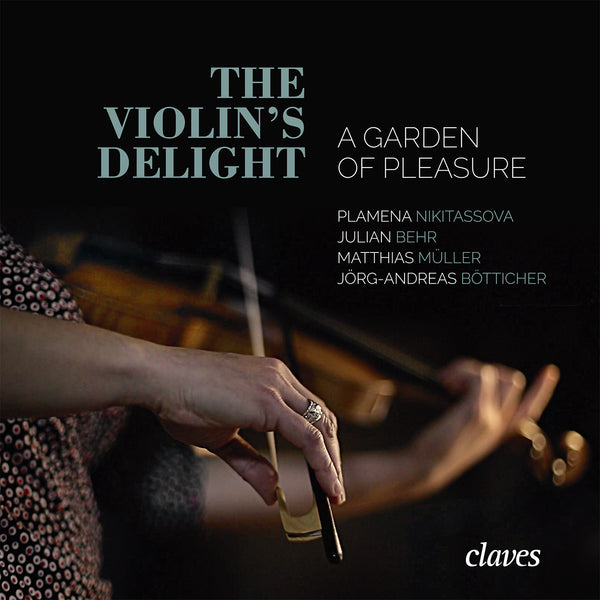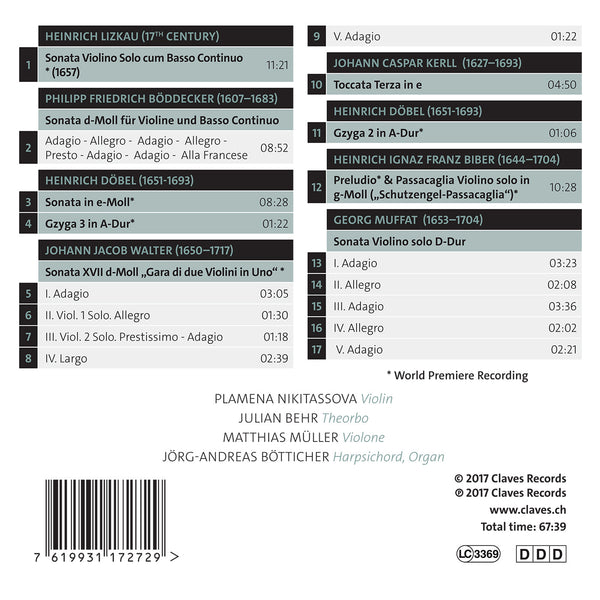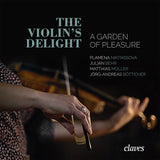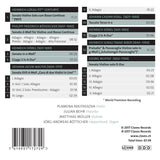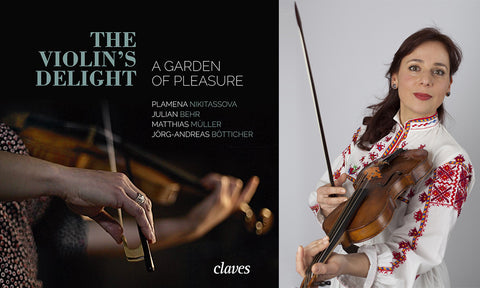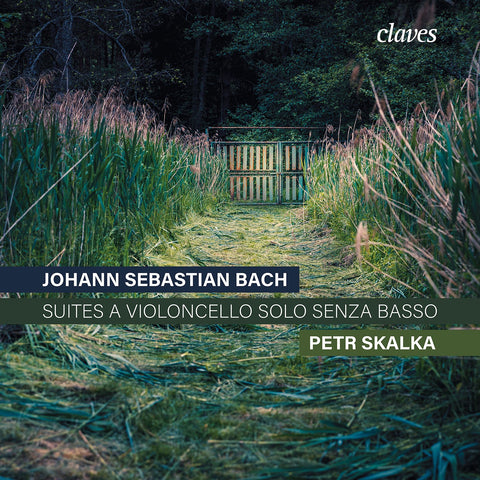(2017) The violin’s delight - a garden of pleasure, 17th Century Virtuoso Violin Music
Kategorie(n): Alte Musik Raritäten
Instrument(e): Cembalo Orgel Geige
Hauptkomponist: Heinrich Ignaz Franz Biber
CD-Set: 1
Katalog Nr.:
CD 1727
Freigabe: 21.07.2017
EAN/UPC: 7619931172729
- UPC: 190374896467
Dieses Album ist jetzt neu aufgelegt worden. Bestellen Sie es jetzt zum Sonderpreis vor.
CHF 18.50
Dieses Album ist nicht mehr auf CD erhältlich.
Dieses Album ist noch nicht veröffentlicht worden. Bestellen Sie es jetzt vor.
CHF 18.50
Dieses Album ist nicht mehr auf CD erhältlich.
CHF 18.50
Inklusive MwSt. für die Schweiz und die EU
Kostenloser Versand
Dieses Album ist nicht mehr auf CD erhältlich.
Inklusive MwSt. für die Schweiz und die EU
Kostenloser Versand
Dieses Album ist jetzt neu aufgelegt worden. Bestellen Sie es jetzt zum Sonderpreis vor.
CHF 18.50
Dieses Album ist nicht mehr auf CD erhältlich.
This album has not been released yet.
Pre-order it at a special price now.
CHF 18.50
Dieses Album ist nicht mehr auf CD erhältlich.
CHF 18.50
Dieses Album ist nicht mehr auf CD erhältlich.
SPOTIFY
(Verbinden Sie sich mit Ihrem Konto und aktualisieren die Seite, um das komplette Album zu hören)
THE VIOLIN’S DELIGHT - A GARDEN OF PLEASURE, 17TH CENTURY VIRTUOSO VIOLIN MUSIC
About this album
“ … Wohl-gepflanzter Violinischer Lust-Garten” (Well-Planted Violin Pleasure Garden) – such was the title employed by Johann Jacob Walther for a second printing of the sonata-like preludes for solo violin and basso continuo originally issued back in 1688. Published in Mainz in 1694, the re-edition reaffirmed his reputation as a virtuoso master violinist with a further compositional calling card. Contrary to what a Baroque “garden” might suggest, as exemplified by the volume’s frontispiece with its perfectly straight axes and neatly fenced-in vegetation, the German violin music of the 17th century is anything but predictable and orderly. The sonatas and dance movements of our recording instead reveal a pleasure in unfettered thinking and experimentation requiring full command of the compositional and technical craft while also unleashing fantastical fabulations of the hands and the mind.
Splendidly appointed courts, such as those found in Vienna, Salzburg and Dresden, cultivated a noble art of intellectually refined entertainment, which included imitative programme pieces along with musical “bizarrities” of the sort that was especially cherished by Olomouc Prince-Bishop Karl Liechtenstein-Castelcorn, situated in the Moravian town of Kromeriz, and which he specifically requested in letters to his resident composers. The spectrum of means mobilised to this end ranged from feigned polyphony on the melodic instrument of violin achieved through double stops and the deliberate mistuning of strings to create unusual resonances (scordatura) up to experimental incursions on the boundaries of Baroque harmonics, with some pieces generating ear-provoking sound effects that would typically be ascribed to 20th century modernism. Not rooted in any desire to please, this sphere combined occult harmonic speculation with bold wit and unbridled virtuosity, evincing the instrumental style’s growing emancipation from the vocal movement framework and demonstrating how artistic skill could provide a rare opportunity for social advancement within a rigid class-based society – as astonishingly attained in the personal biographies of figures like Biber, Schmelzer, Walther and Kerll.
Plamena Nikitassova
The Bulgarian violinist Plamena Nikitassova initially studied classical violin under M. Karafilova Piguet at the Geneva College of Music and under Professor M. Frischenschlager at the Vienna College of Music. After graduating from her teaching and soloist degree with honours in Geneva in 1999, Nikitassova turned to early music and began studying Renaissance and Baroque violin under Chiara Banchini at the Schola Cantorum Basiliensis, where she graduated in 2005.
She focussed on working as a soloist and duet partner with the harpsichord player and organist Jörg-Andreas Bötticher, and the pianist and conductor Rudolf Lutz. Her CD recordings, including ’Violin Sonatas by C. Zuccaru’, Panclassics 2012 (Diapason d’Or Découverte), ‘Violin Sonatas by Gaspard Fritz 1747’, Panclassics 2014, and ‘Violin Sonatas by L. v. Beethoven, M. Ravel, C. Debussy’, Gallus Media 2014, were warmly received with high praise from the public and the press.
She enthusiastically tackles the worlds of early and classical music as well as Eastern European folk music, where she feels most at home. The violinist Plamena Nikitassova’s repertoire focusses on works of the Early Baroque to Romantic music.
Plamena Nikitassova is concertmaster of the ‘J. S. Bach Stiftung’ Orchestra, St.Gallen, since 2013.
In this recording, she is playing violin in an old scale by Jacobus Stainer ( Absam1659 ).
Julian Behr
Julian Behr initially studied in classical guitar and lute with Mario Sicca and Robert Barto at the State University of Music and performing Arts Stuttgart. After completing post-graduate studies in lute performance with Joachim Held at the Hamburg Conservatory, Julian Behr studied Early Music and lute instruments at the Schola Cantorum Basiliensis in Basle with Hopkinson Smith.
Julian Behr taught at the Nuremberg University of Music from 2007 until 2011. He appeared at festivals in most European countries and in South America with the Belgian Ensemble Ausonia, with the Akademie für Alte Musik Berlin, with Al Ayre Espagnol, Peter Kooj and Sette Voci and with the countertenors Franz Vitzthum and Andreas Scholl.
Alongside soloistic and chamber music projects, his work includes playing in productions of baroque operas at the opera houses in Hamburg, Berlin, Amsterdam, Sidney and Brussels, amongst others.
Matthias Müller
Matthias Müller studied at the Freiburg College of Music. As an internationally sought-after continuo player, he has pursued an extensive performing career and participated in many CD productions. His instrumentarium encompasses the entire viola da gamba family, including the violone and lira da gamba. In addition to chamber music, he has a special predilection for the vocal music of the sixteenth and seventeenth centuries.
Since 2000 he has been a regular member of the ensemble Cantus Cölln. In addition, he performs and records with various other ensembles, including the Dresden Chamber Choir, Balthasar-Neumann-Chor, Concerto Palatino, Holland Baroque, the Stuttgart Chamber Choir, Les Cornets Noirs, La dolcezza, the Freiburg Baroque Orchestra, Les Passions de l`Ame, Vox Luminis, and others.
About this album
“ … Wohl-gepflanzter Violinischer Lust-Garten” (Well-Planted Violin Pleasure Garden) – such was the title employed by Johann Jacob Walther for a second printing of the sonata-like preludes for solo violin and basso continuo originally issued back in 1688. Published in Mainz in 1694, the re-edition reaffirmed his reputation as a virtuoso master violinist with a further compositional calling card. Contrary to what a Baroque “garden” might suggest, as exemplified by the volume’s frontispiece with its perfectly straight axes and neatly fenced-in vegetation, the German violin music of the 17th century is anything but predictable and orderly. The sonatas and dance movements of our recording instead reveal a pleasure in unfettered thinking and experimentation requiring full command of the compositional and technical craft while also unleashing fantastical fabulations of the hands and the mind.
Splendidly appointed courts, such as those found in Vienna, Salzburg and Dresden, cultivated a noble art of intellectually refined entertainment, which included imitative programme pieces along with musical “bizarrities” of the sort that was especially cherished by Olomouc Prince-Bishop Karl Liechtenstein-Castelcorn, situated in the Moravian town of Kromeriz, and which he specifically requested in letters to his resident composers. The spectrum of means mobilised to this end ranged from feigned polyphony on the melodic instrument of violin achieved through double stops and the deliberate mistuning of strings to create unusual resonances (scordatura) up to experimental incursions on the boundaries of Baroque harmonics, with some pieces generating ear-provoking sound effects that would typically be ascribed to 20th century modernism. Not rooted in any desire to please, this sphere combined occult harmonic speculation with bold wit and unbridled virtuosity, evincing the instrumental style’s growing emancipation from the vocal movement framework and demonstrating how artistic skill could provide a rare opportunity for social advancement within a rigid class-based society – as astonishingly attained in the personal biographies of figures like Biber, Schmelzer, Walther and Kerll.
Plamena Nikitassova
The Bulgarian violinist Plamena Nikitassova initially studied classical violin under M. Karafilova Piguet at the Geneva College of Music and under Professor M. Frischenschlager at the Vienna College of Music. After graduating from her teaching and soloist degree with honours in Geneva in 1999, Nikitassova turned to early music and began studying Renaissance and Baroque violin under Chiara Banchini at the Schola Cantorum Basiliensis, where she graduated in 2005.
She focussed on working as a soloist and duet partner with the harpsichord player and organist Jörg-Andreas Bötticher, and the pianist and conductor Rudolf Lutz. Her CD recordings, including ’Violin Sonatas by C. Zuccaru’, Panclassics 2012 (Diapason d’Or Découverte), ‘Violin Sonatas by Gaspard Fritz 1747’, Panclassics 2014, and ‘Violin Sonatas by L. v. Beethoven, M. Ravel, C. Debussy’, Gallus Media 2014, were warmly received with high praise from the public and the press.
She enthusiastically tackles the worlds of early and classical music as well as Eastern European folk music, where she feels most at home. The violinist Plamena Nikitassova’s repertoire focusses on works of the Early Baroque to Romantic music.
Plamena Nikitassova is concertmaster of the ‘J. S. Bach Stiftung’ Orchestra, St.Gallen, since 2013.
In this recording, she is playing violin in an old scale by Jacobus Stainer ( Absam1659 ).
Julian Behr
Julian Behr initially studied in classical guitar and lute with Mario Sicca and Robert Barto at the State University of Music and performing Arts Stuttgart. After completing post-graduate studies in lute performance with Joachim Held at the Hamburg Conservatory, Julian Behr studied Early Music and lute instruments at the Schola Cantorum Basiliensis in Basle with Hopkinson Smith.
Julian Behr taught at the Nuremberg University of Music from 2007 until 2011. He appeared at festivals in most European countries and in South America with the Belgian Ensemble Ausonia, with the Akademie für Alte Musik Berlin, with Al Ayre Espagnol, Peter Kooj and Sette Voci and with the countertenors Franz Vitzthum and Andreas Scholl.
Alongside soloistic and chamber music projects, his work includes playing in productions of baroque operas at the opera houses in Hamburg, Berlin, Amsterdam, Sidney and Brussels, amongst others.
Matthias Müller
Matthias Müller studied at the Freiburg College of Music. As an internationally sought-after continuo player, he has pursued an extensive performing career and participated in many CD productions. His instrumentarium encompasses the entire viola da gamba family, including the violone and lira da gamba. In addition to chamber music, he has a special predilection for the vocal music of the sixteenth and seventeenth centuries.
Since 2000 he has been a regular member of the ensemble Cantus Cölln. In addition, he performs and records with various other ensembles, including the Dresden Chamber Choir, Balthasar-Neumann-Chor, Concerto Palatino, Holland Baroque, the Stuttgart Chamber Choir, Les Cornets Noirs, La dolcezza, the Freiburg Baroque Orchestra, Les Passions de l`Ame, Vox Luminis, and others.
Return to the album | Read the booklet | Composer(s): Heinrich Ignaz Franz Biber | Main Artist: Plamena Nikitassova
STUDIO-MASTER (HOCHAUFLÖSENDES AUDIO)
Alte Musik
Amethys Design
Auf Lager
Cembalo
Geige
Heinrich Ignaz Franz Biber (1644-1704)
High-resolution audio - Studio master quality
Johann Caspar Kerll (1627-1693)
Julian Behr
Jörg-Andreas Bötticher
Matthias Müller
Orgel
Plamena Nikitassova - violin
Populäre Alben
Raritäten
Releases 2015 - 2017
World Premiere Recording
Alte Musik
Amethys Design
Auf Lager
Cembalo
Geige
Heinrich Ignaz Franz Biber (1644-1704)
High-resolution audio - Studio master quality
Johann Caspar Kerll (1627-1693)
Julian Behr
Jörg-Andreas Bötticher
Matthias Müller
Orgel
Plamena Nikitassova - violin
Populäre Alben
Raritäten
Releases 2015 - 2017
World Premiere Recording







